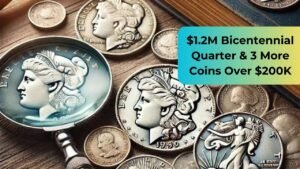Few rare U.S. coins are as distinctive and coveted as the $3 Gold Coin. Produced by the U.S. Mint from 1854 to 1889, the coin is significant in numismatic history because of its low mintage, uncommon denomination, and historic value. Collectors today actively pursue high-grade examples, with some fetching hundreds of thousands of dollars in auction.
In this article, we’ll explore why the $3 Gold Coin is so rare, its historical background, key design features, and how much it’s worth today.
The History of the $3 Gold Coin
The $3 Gold Coin debuted in 1854, as the U.S. government was looking for methods to make commerce easier. The idea behind the denomination was that it would be handy to buy sheets of 100 three-cent stamps (which were commonly used to mail letters at the time). This never caught on widely, and as a result, production numbers remained low.
- Mintage Years: 1854 –1889
- Total Coins Struck: Approximately 535,000 total over all years and mints
- Last Year of Production: 1889
Because of its low usage and small production, the $3 Gold Coin soon became a numismatic rarity.
What Makes the $3 Gold Coin So Rare?

1. Unusual Denomination
The $3 denomination was a first in U.S. history and was not popular with the public. Because of this, few were made, and even fewer exist today.
2. Limited Mintage
Fewer than 535,000 coins were produced in the coin’s 35-year history, well below other U.S. gold coins of the period. Some production years were very low, making some dates worth a great deal of money.
3. Gold Content
Each $3 coin contained 90% gold and 10% copper and had a rich yellow-gold color. With its high gold content, it is valuable even if worn out.
4. Survival Rate
Most of these coins were destroyed by being melted down when the United States converted from the gold standard, lowering the number of surviving examples even more.
Design & Features of the $3 Gold Coin
Created by James Barton Longacre, the $3 Gold Coin contains:
- Obverse (Front): Lady Liberty adorned in a Native American headdress with the inscription of “United States of America.”
- Reverse (Back): A wreath of cotton, wheat, corn, and tobacco surrounding the denomination “3 DOLLARS” and the date of issue.
This elaborate design renders it one of the most visually stunning coins in U.S. history.

Most Valuable $3 Gold Coins
There exist some uncommon Rare Date and Mint mark combinations that have sold for astronomical prices at auction. Following are some of the most expensive $3 Gold Coins:
- 1854 $3 Gold Coin: Available for lower prices because it has a relatively higher mintage.
- 1875 Proof $3 Gold Coin: Extremely rare, selling for premiums. Proof coins are especially sought after due to their sharp details and mirror-like appearance.
- 1870-S $3 Gold Coin: One known specimen may fetch millions were it ever come on the market. Its scarcity makes it the symbol of American numismatics.
How to Identify an Authentic $3 Gold Coin
If you believe you own an authentic $3 Gold Coin, do these:
- Check for weight: Its official weight is 5.015 grams.
- Check the diameter: It would be 20.5 mm.
- Search for mint marks: On the reverse side, beneath the wreath.
- Have it authenticated: Companies that grade professionally such as PCGS or NGC can authenticate its value and legitimacy.
Final Thought
The $3 Gold Coin is America’s rarest and most fascinating numismatic treasure. As a professional or an amateur, being in possession of one of these historical coins can prove to be an excellent investment. Should you happen to lay hands on a $3 Gold Coin, get it appraised immediately—it might just be worth millions!
FAQ’s
How scarce is the $3 Gold Coin?
The $3 Gold Coin is very rare because of its low mintages. Some years, such as 1875 and 1876, had only proof coins struck. The 1870-S coin is one of a kind, with only one example known to exist.
Why was the $3 Gold Coin issued?
The $3 Gold Coin was issued to make it easier to buy full 100-stamp sheets following postal reforms that lowered the price of stamps to three cents. It was also part of larger initiatives to modernize U.S. currency in the mid-19th century.



